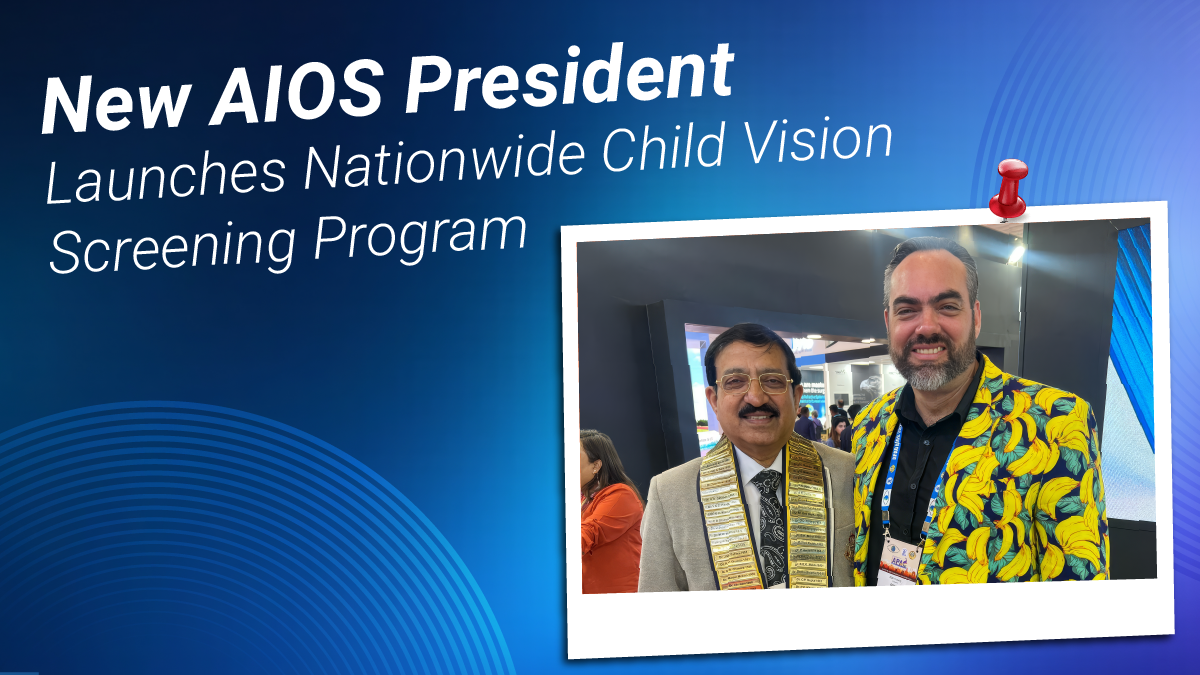Incoming AIOS President Dr. Biswas announces his ambitious plans for a year of tackling blindness and low vision in India.
If the conclusion of the 40th Asia-Pacific Academy of Ophthalmology Congress, held in conjunction with the 83rd Annual Conference of the All India Ophthalmological Society (APAO-AIOC 2025), taught us anything, it’s that India is stepping into a leading global role in eye care.
On the Conference’s final day, incoming All India Ophthalmological Society (AIOS) President Dr. Partha Biswas sat down with CAKE Publisher and Media MICE CEO Matt Young to talk about India’s increasing footprint in eye care, and to articulate his broader public health vision for the year ahead—one that he hopes will extend beyond organizational duties to advance national public health goals.
“I wish to have a very meaningful year for the All India Ophthalmological Society, but it should transcend the needless blindness which is here [in India],” he said.
MICE TV Spotlight on APAO-AIOC 2025: Innovation and Industry in Indian Ophthalmology
National screening effort to address myopia and refractive error
So what are Dr. Biswas’ big plans? They start with a nationwide program to screen school-age children for refractive error throughout 2025, under what he has called the “Year of the Child” initiative. The campaign aims to detect vision problems early and reduce the rate of amblyopia among underserved populations.
For Dr. Biswas, the logic behind this is clear. “If we don’t detect refractive error, then we do not know that this child has refractive error. The child does not know. The parents don’t understand,” he said.
The school screening program is being carried out in partnership with the Indian government and targets both urban and rural areas.
In addition to refractive error, the initiative will focus on identifying children at risk for retinopathy of prematurity (ROP) and other causes of preventable blindness. Recent studies indicate that ROP affects 20-30% of preterm infants in India, with approximately 10% requiring treatment. The incidence is particularly high in babies weighing less than 1500g at birth, where rates can reach up to 45%.1
Dr. Biswas emphasized the role of such actions in addressing India’s urban-rural disparities: “It is a difficult task… The science behind [ROP] is not always available for every part of India, especially in the rural areas where childhood blindness is more because of undernourished mothers and ill-nourished children.”
READ MORE: Seeing Beyond Ocular Signs: Systemic Disorders in Pediatric Patients
Looking ahead to Jaipur and the year to come
With the APAO-AIOC 2025 meeting concluded, attention has already turned to Jaipur, which will host next year’s annual conference of the AIOS.
As the torch officially passes to Dr. Biswas for the 2025–2026 term, his focus on impactful leadership and international collaboration is already taking shape. The upcoming AIOC 2026 event promises to build on the momentum of APAO-AIOC 2025, with significant faculty representation from both India and abroad. According to Dr. Biswas, Jaipur’s strong connectivity and status as a cultural destination are expected to draw significant attendance.
In addition to ongoing pediatric vision initiatives, Dr. Biswas highlighted diabetic retinopathy and surgical safety standards as continued priorities under his leadership. “We have to think about the strategies and the safety features of eye surgery. And that has to become a protocol as much as possible.”
Ophthalmology Breakthroughs from APAO-AIOC 2025 India
Global summit planned for 2026 to showcase India’s model
To address the growing challenge of diabetic retinopathy, Dr. Biswas also announced a strategic partnership with the Vitreo Retina Society of India (VRSI). This collaboration aims to develop standardized screening protocols and improve access to treatment across India, particularly in underserved regions.
India has also been selected as the host country for the first-ever Global Eye Health Summit, a joint initiative with the International Agency for the Prevention of Blindness (IAPB), WHO and the UN. The summit is expected to be held in Delhi in 2026.
Dr. Biswas cited India’s long-standing national blindness control programs, well-established public-private partnerships and low-cost surgical innovations as key reasons for the country’s selection.
“India already has a roadmap,” he said. “There have been innovations in how to treat blindness or cataract blindness or needless blindness… These are low-cost innovations which can be emulated anywhere else in the world.”
India’s cataract surgery models, which include reduced reliance on disposable surgical supplies and sterilization strategies tailored for high-volume procedures, have demonstrated safety rates on par with high-income countries, he added.
Dr. Biswas emphasized the broader societal implications of untreated childhood vision problems, noting how they can have far-reaching societal impacts. He discussed how poor vision affects not only academic performance but also cognitive development and future productivity, potentially transforming what could be productive members of society into individuals requiring long-term support.
Dr. Biswas also highlighted sustainability in eye care as a growing concern. He pointed to India’s evolving surgical practices, where balancing sterility with cost-effectiveness is a top priority, noting that India has developed cost-effective protocols for maintaining surgical sterility without compromising safety outcomes.
With major policy initiatives on childhood blindness, diabetic retinopathy and global collaboration underway, 2025 is shaping up to be a significant year for AIOS in advancing India’s leadership in global eye health.
Editor’s Note: Reporting for this story took place during the 40th Congress of the Asia-Pacific Academy of Ophthalmology (APAO 2025), held in conjunction with the 83rd Annual Conference of the All India Ophthalmological Society (AIOC 2025) from 3-6 April in New Delhi, India.
READ MORE: Enhancing Pediatric Vision in Demyelinating and Neuromuscular Conditions
Reference
- Kulkarni S, Gilbert C, Zuurmond M, Agashe S, Deshpande M. Blinding Retinopathy of Prematurity in Western India: Characteristics of Children, Reasons for Late Presentation and Impact on Families. Indian Pediatr. 2018;55(8):665-670.
